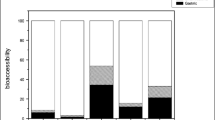Abstract
In six different ordinary vegetables, namely kohlrabi, Chinese cabbage, chard, leek, spinach and Jerusalem artichoke, zinc was mainly found as low molecular weight species. In the present study, these important zinc compounds are further investigated. The determinations of the metal are performed by ET-AAS. The zinc complexes of all vegetables are anionic at pH 8.0 and show similar elution behaviour in gel permeation and anion exchange chromatography. Consequently, a great resemblance in structure between the low molecular weight zinc species from the different vegetables can be supposed. Exemplary, the zinc complexes of kohlrabi and Chinese cabbage are further examined. In more purified samples of these vegetables compared to zinc neither stoichiometric amounts of free protein amino acids nor nicotianamine, free malic acid, citric acid or phytic acid have been detected. Mainly glutamic acid is found in molar excess to zinc after acid hydrolysis in both cases. The cysteine contents of both zinc-binding fractions are very low. Conclusively, the wellknown γ-glutamylcysteinyl-glycines (phytochelatines) can not be responsible for the bonding of zinc in both ordinary vegetables. We suppose that zinc in kohlrabi and Chinese cabbage is bound to a glutamic acid derivative unknown as yet, possibly a malic acid ester.
Similar content being viewed by others
Literatur
Kruse-Jarres JD (1990) VitaMinSpur 5: 6–17
Schmidt K, Bayer W (1983) Die Bedeutung des Zinks in der Medizin. Verlag für Medizin, Dr. E. Fischer, Heidelberg
Bernhard M, Brinckman FE, Sadler PJ (1986) The importance of chemical speciation in environmental processes, Dahlem Konferenzen. Springer, Berlin Heidelberg New York
Deutsche Gesellschaft für Ernährung (Hrsg) (1984) Ernährungsbericht 1984, DGE Frankfurt/Main
Recommended Dietary Allowances (1989) 10th edn. National Academy Press, Washington DC, S 207
Pfannhauser W (1988) Essentielle Spurenelemente in der Nahrung. Springer, Berlin Heidelberg New York
Elmadfa I, Leitzmann C (1990) Ernährung des Menschen. 2. überarb. Aufl., Ulmer, Stuttgart, S 204
Grill E, Winnacker E-L, Zenk MH (1985) Science 230: 674–676
Grill E, Zenk MH (1989) Chemie in unserer Zeit 23: 193–199
Grill E, Löffler S, Winnacker E-L, Zenk MH (1989) Proc Natl Acad Sci USA 86: 6838–6842
Jackson PJ, Roth EJ, McLure PR, Naranjo CM (1984) Plant Physiol 75: 914–918
Jackson PJ, Naranjo CM, McLure PR, Roth EJ (1985) Cellular and molecular biology of plant stress. In: Key JL, Kosuge T (eds) Proceedings of ARCO Plant Cell Research Institute. Liss, New York
Jackson PJ, Unkefer CJ, Doolen JA, Watt K, Robinson NJ (1987) Proc Natl Acad Sci USA 84: 6619–6623
Hayashi Y, Nakagawa CW, Murasugi A (1986) Environ Health Perspec 65: 13–19
Gekeler W, Grill E, Winnacker E-L, Zenk MH (1988) Arch Microbiol 150: 197–202
Vögli-Lange R, Wagner GJ (1990) Plant Physiol 92: 1086–1093
Walker CD, Welch RM (1987) J Agric Food Chem 35: 721–727
Klapheck S, Schlunz S, Bergmann L (1995) Plant Physiol 107: 515–521
Zhou J, Goldsbrough PB (1994) Plant Cell 6: 875–884
Kinnersley AM (1993) Plant Growth Regul 12: 207–218
Kneer R, Zenk MH (1992) Phytochem 31: 2663–2667
Abrahamson SL, Speiser DM, Ow DW (1992) Anal Biochem 200: 239–243
Howden R, Cobbett CS (1992) Plant Physiol 100: 100–107
Jackson PP, Robinson NJ, Whitton BA (1991) Environ Exp Bot 31: 359–366
Mathys W (1977) Physiol Plant 40: 130–136
Tomsett AB, Thurman DA (1988) Plant Cell and Environ 11: 383–394
Krotz RM, Evangelou BP, Wagner GJ (1989) Plant Physiol 91: 780–787
Godbold DL, Horst WJ, Collin JC, Thurman DA, Marschner H (1984) J Plant Physiol 116: 59–69
White MC, Decker AM, Chaney RL (1981) Plant Physiol 67: 292–300
White MC, Baker FD, Chaney RL, Decker AM (1981) Plant Physiol 67: 301–310
Thurman BA, Rankin JL (1982) New Phytol 91: 629–635
Van Steveninck RFM, Van Steveninck ME, Fernando DR, Horst WJ, Marscher H (1987) J Plant Physiol 131: 247–257
Van Steveninck RFM, Babare A, Fernando DR, Van Steveninck ME (1994) Plant Soil 167: 157–164
Van Steveninck RFM, Babare A, Fernando DR, Van Steveninck ME (1993) Dev Plant Soil Sci 54: 775–778
Van Steveninck RFM, Babare A, Fernando DR, Van Steveninck ME (1993) Plant Soil 155/156: 525–528
Gomah AM, Davies RI (1974) Plant and Soil 40: 1–19
Zhang F, Romheld V, Marschner H (1991) J Plant Nutr 14: 675–686
Schreiber K (1990) Mittbl Chem Ges 37: 1577–1579
Günther K, Waldner H (1992) Anal Chim Acta 259: 165–173
Günther K, von Bohlen A, Strompen C (1995) Anal Chim Acta 309: 327–332
Schneider S (1993) Diplom-Arbeit, Universität Bonn
Slavin W, Carnrick GR, Manning DC, Pruszkowska E (1983) At Spectrosc 4: 69; Perkin-Elmer Handbuch HGA-400 Subsection 1, Recommended conditions for standard graphite furnance AAS (STPF conditions)
Ozols J (1990) Methods in Enzymology 182: 587–601
Hancock WS (Ed) (1984), CRC Handbook of HPLC for separation of Amino Acids, Peptides and Proteins, Volume II. CRC Press Inc, Boca Raton, Florida
Stryer L (1990) Biochemie. Spektrum der Wissenschaft, Heidelberg
Author information
Authors and Affiliations
Additional information
Gewidmet dem Andenken an Prof. Dr. Konrad Pfeilsticker, 1970–1994 Ordinarius für Lebensmittelwissenschaft und Lebensmittelchemie an der Universität Bonn
Rights and permissions
About this article
Cite this article
Waldner, H., Günther, K. Charakterisierung niedermolekularer Zinkspezies in handelsüblichen pflanzlichen Lebensmitteln. Z Lebensm Unters Forch 202, 256–262 (1996). https://doi.org/10.1007/BF01263550
Received:
Issue Date:
DOI: https://doi.org/10.1007/BF01263550




